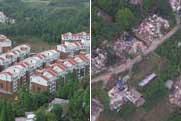China
China´s Academy of Launch Vehicle Technology
WATCH VIDEO
The Shenzhou spacecraft has three parts, an orbital module, a service module, and a compartment for the crew. After leaving Earth, the three parts detach and only the crew compartment, also known as the re-entry capsule, will return to earth intact after the voyage. So it's the returning capsule that's the control center for the entire spacecraft. The museum has a model of the Shenzhou 5 capsule which housed a legend of China's space travel program.
The Long March 2F rocket will be launched from Jiuquan Satellite Launch Center in Gansu province at the end of September. Of the three astronauts traveling on Shenzhou 7, one will do a spacewalk. They will be in space for five full days, the longest Chinese mission to date.
Chen Minkang, Director of System Department, CALT, said, "The Shenzhou7 mission is more difficult than previous ones because a spacewalk is involved. The rocket's technological improvements include two aspects. Firstly, it was designed to be more reliable than past versions and secondly, some technical methods were applied to provide a more comfortable environment inside the capsule for the astronauts, especially during the period from take off and disintegration with the spacecraft."
In the museum, there is a demonstration of command station situations during takeoff. Weather conditions, different camera views and the spacecraft's motion in orbit are all provided on the monitoring screens.
The China National Space Administration, responsible for the national space program, is making great efforts towards aerospace development, upgrading launch vehicles, developing satellite technology and positioning.
Chen Minkang, Director of System Department, CALT, said, "As a system designer, we are devoted to push forward China's aerospace technology in three areas. We must build environment-friendly rockets with tonic-free and pollution-free propeller that use liquid hydrogen, loxygen and kerosene as its fuel. Improved reliability will be reflected in the design and production of rockets. The launch vehicle will be upgraded to adapt with bigger and heavier satellite and spacecraft. We are also working hard towards launching satellite into orbits further than the earth and the moon."
Shenzhou-7 will be a big step from previous missions. Shenzhou 8 and 9 have also been planned, and will be launched unmanned, but with space laboratory modules with two docking ports. They will then be followed by the manned Shenzhou 10, which is expected to operate the station for some time.
| Comment
|
Interactive: Be part of China's journey to space!
Editor:Zhang Pengfei



